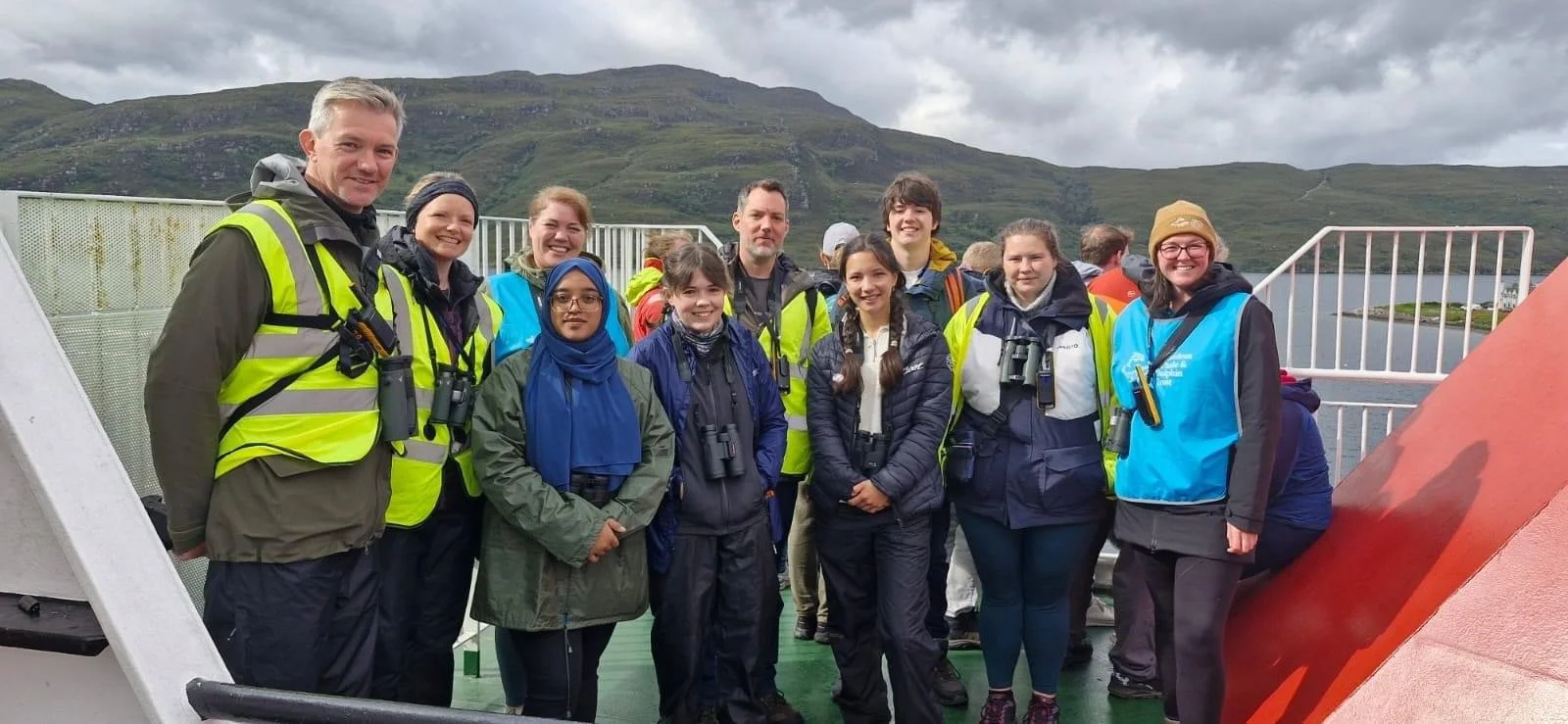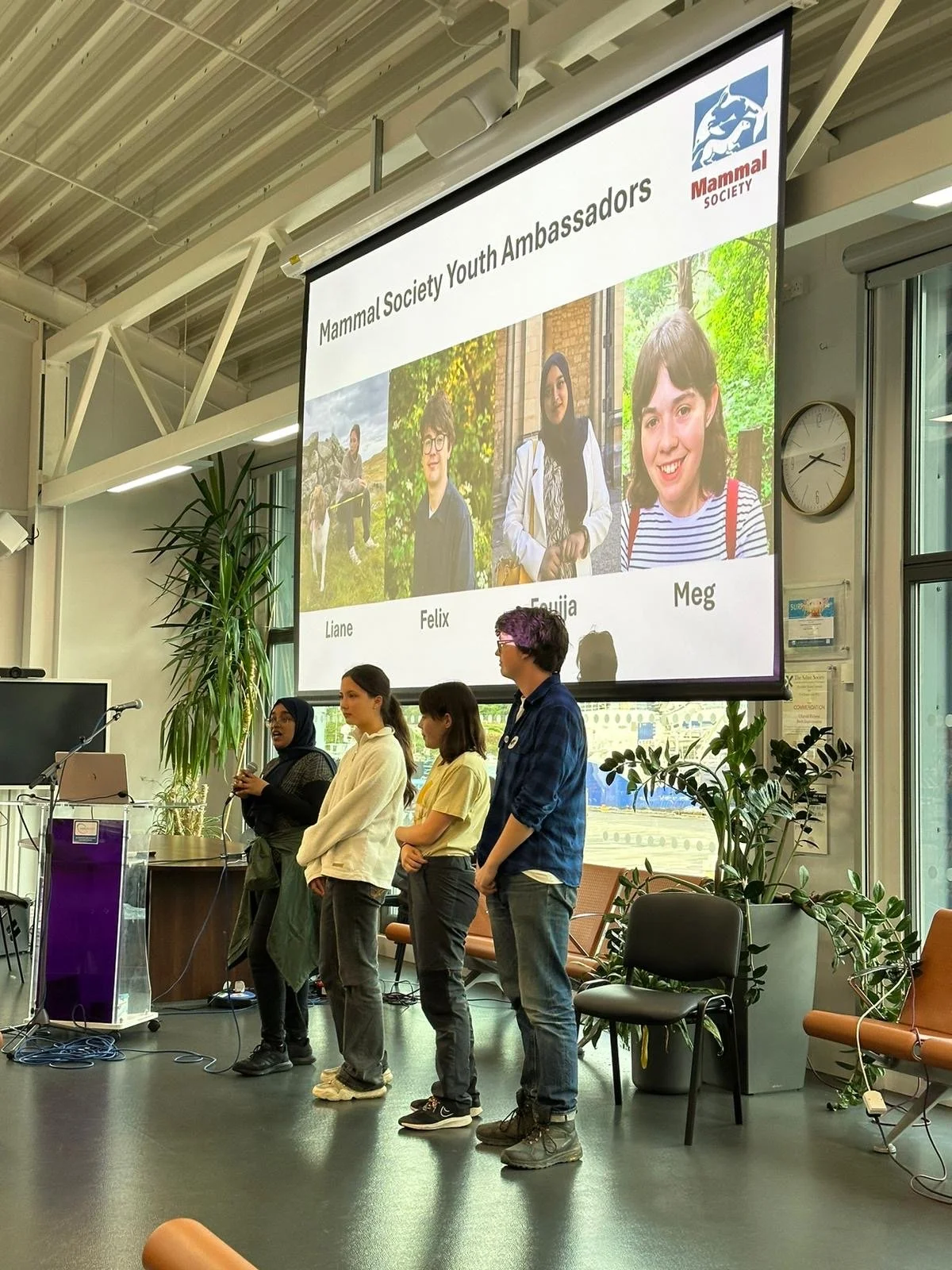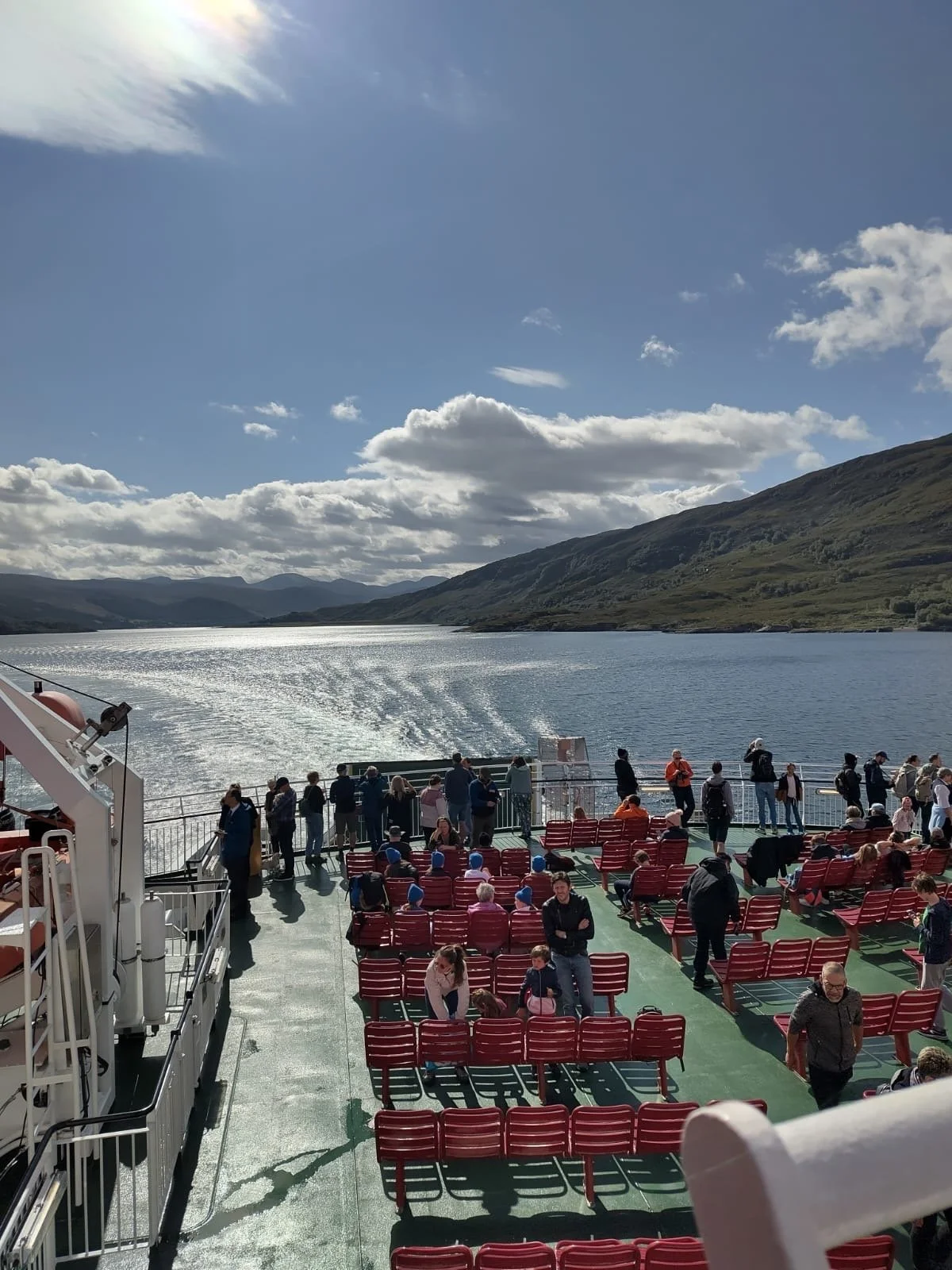CalMac Ferry Crossings
Mammal Societies first Youth Ambassadors recently spent a week up in the Scottish Highlands - hear from YA Meg about her experience!
The CalMac Ferry crossings was an three day event of surveying marine mammals on the ferry route between Ullapool and Stornoway. Alongside the Mammal Society we would also be joined by Hebridean Whale and Dolphin Trust and Wild Discovery. In order to help towards collecting crucial data and teaching the public the importance of citizen science.
The survey and engagement team on the MV Loch Seaforth. Pictured are Dan and Rachel of Wild Discovery (Left), Alison and Morven of Hebridean Whale and Dolphin Trust (Blue bibs), Mammal Societies new Youth Ambassadors and staff members Fiona and Matt.
Day 1: 06/08/2024
The first day that the ferry crossings took place, started off as a nervous but exciting day. This would be the first time all us youth ambassadors would meet in person. We’d only met on training calls before the ferry crossings. These training calls made sure we knew how to collect data properly and gave us the opportunity to learn more about some of the species we may see. After setting up our information stand in the Ullapool ferry terminal, we departed at 10:30am on the 2hr and 40 minute journey to Stornoway.
On this first journey across we were lucky to start off by spotting common dolphins and a humpback whale. This was amazing to see a humpback whale on our first journey, as minke whale (or slinky minkes) are much more common in the Minch. We were able to spot this humpback due to the whale’s blow. Which for humpback whales often look quite bushy or cloud like and hangs in the air. Compared to the blow of for example a fin whale where the blow is a straight line.
While on the way back we saw 2 more humpback whales with even more common dolphins. I had the opportunity to see what it was like on the bridge of the boat seeing all of the equipment and an amazing view. The people on the bridge to radio back to the people on the deck to get the public looking in the right direction and engage them in helping us spot whales and get them learning about the environment around them. The weather conditions on the first day were good and calm meaning that there was good visibility and we were able to spot many of the signs that the whales were in the area by spotting splashes and the blows of the whales.
Mammal Societies YA's after a sunny first ferry crossing. PC: Foujia.
In the evening we hosted talks in the ferry terminal in Ullapool. A talk was given by each of the 3 groups including a brief introduction into who we were as youth ambassadors. This was a great way to engage the public in Ullapool and encourage them to use the app Whale Track to help us collect more data than just the 3 days we were there. These talks helped to encourage a fair few families to come on the ferry on over the next few days and taught me a lot about what the environment in Scotland is like. The talks also covered some of the problems which could cause the decrease of many mammals found in the seas surrounding Scotland. This is important to teach the public about because nature loss is as big a threat as climate change, since healthy landscapes and seas filled with varied life are vital for our own survival.
Healthy, balanced and thriving ecosystems keep us fed, healthy and protected from natural challenges such as flooding and drought.
Mammal Society Youth Ambassadors presenting at the evening event.
Day 2: 07/08/2024
Ferry Terminal experience by Meg
On the second day, we were offered to either go out on the ferry or stay in the ferry terminal to experience the public engagement side of conservation. Both public engagement and field work are equally important for conservation if more people understand our environment it will help conservation efforts all over the world. Staying at the information stand meant talking to the public and explaining what the different groups are about and showing them some of the specimens we had on display such as a minke whale jaw bone and pilot whale skull.
During the quiet parts of the day me and Liane worked on one of the other surveys being carried out by the Mammal Society that involved dissecting owl pellets to try and find evidence of the Greater white-toothed shrew a non-native species. This survey is trying to track the spread of the Greater white-toothed shrew and its impact on native shrew species. Dissecting owl pellets and recording the bones was a strangely therapeutic process and I would highly recommend taking part in this survey!
We encouraged people to become a citizen scientist and use some of our apps to help record more conservation data in different environments. Some of these apps include Mammal Mapper (for while on land), Whale Track (for while at sea in Scotland), and at sea in rest of UK - Sea Watcher. Anyone can become a citizen scientist and can help out conservation through using these apps when they are travelling or even while out on their usual walk.
That evening we went out on a walk to see if we could see any Eurasian otters which can often be found in Ullapool. Unfortunately we weren’t lucky enough to see any of them but we found signs of that they had been there. Some of the signs we found included trails in the grass of where they would be travelling to access the water to hunt, as well as otter spraint (Otter faeces) which is said to smell like Jasmine tea.
The ferry terminal stand - complete with life-sized inflatable porpoise!
Ferry crossing experience by Foujia
On the second day of the trip, I got the opportunity to join Rachel from Wild Discovery and the ferry captain on the bridge. I saw a pod of 9 dolphins and briefly a minke whale as well! We were able to see a few blows in the distance that we suspect indicated humpback whales in the region, and maybe even a fin whale, but the poor visibility and grim weather made it impossible to confirm.
It wasn't the most successful of days on deck either, with very few sightings and really strong winds and tall waves. But through a lot of perseverance and an infinite amount of clothing layers, we were able to make the most out the day; with the few sightings feeling extra special and hard-earned!
Youth Ambassadors pointing at (but not smelling) fresh otter spraint!
Day 3: 08/09/2024
The final day was an incredible day to finish, because of what we saw and the number of people who engaged with our survey. We had many people come up to us who had either talked to our representatives at our information stall or had come to the talks that had been given on the first day. This just proves the vital effects public engagement can have on conservation surveys by making people more interested in their local ecosystems.
The day started off strong through our sightings not of mammals but of 2 white-tailed eagles (otherwise known as the sea eagle). Which got many of the people on board motivated to spot more animals after seeing the largest bird of prey we have in Britian.
On the way across to Stornoway we saw many pods of common dolphins and a few humpback whales. However, on the way back we saw 4 humpback whales along with 2 groups of minke whales. The minkes came very close alongside the ferry and for a long enough time that everyone on board managed to see them. It was an amazing that everyone on board was able to see. Finally, on our way back into Ullapool we saw massive amounts of common dolphin - over 45 was we came back into port which gave everyone one last opportunity to see the amazing mammals we can find in this part of Scotland before having to say goodbye to start our long travels back home.
Sun and flat calm conditions - every cetacean surveyours dream!
Overall, this experience has shown me just one of the amazing ecosystems we have in the UK and taught me how important citizen science is for conservation. The trip taught me how amazing our conservation charities are that we have in the UK and that many of them need our help through completing surveys or donations to help protect our ecosystems from effects like invasive species and climate change.
You can join the mammal society or make a donation at www.mammal.org.uk to allow more young people in the future to become youth ambassadors as well as give the charity more opportunity to go out and record more data on our UK mammals which are severely under unrecorded. Which could help us conserve our ecosystems for many years to come.
The data! Kindly prepared by HWDT.







